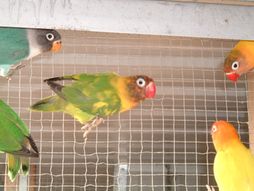|
|
Post by AussieBirds on Oct 7, 2004 22:57:38 GMT 10
This love bird was purchased as a normal mask hen she has changed colour dramiticaly.  [glow=red,2,300]John[/glow] |
|
|
|
Post by birds77 on Oct 8, 2004 0:05:37 GMT 10
Hi John,
That lovebird looks pied in the pic. nice looking bird as well, well i think so.
Anna
|
|
|
|
Post by fischer on Oct 8, 2004 3:15:03 GMT 10
Hi John,
Do you know how old the hen was when you bought it?
I have some older birds that look a bit like yours, they seem to loose some of the green pigment in their feathers with age.Iv'e
got about 60 masks and only a few have shown this trait.
If its a young bird, it could have some pied in it or maybe some yellow. It will be interesting to see what young she brings out. She's a nice big bird and actually looks a bit like she's carrying eggs now.
Tony
Please let me know when you have some greens andsame yellows for sale, my birds are pretty much all from the source, I need some new blood.
|
|
|
|
Post by AussieBirds on Oct 8, 2004 10:15:14 GMT 10
She is at least 12 months old Tony as she has bred and is sitting on eggs at the moment. I was told once that the colour pigmentation was a sign of liver disease but she is very healthy and is one of my best breeders, Im tipping she is a pied like Anna said.
John
|
|
eckie
Bronze Member
  
Posts: 223
|
Post by eckie on Oct 13, 2004 16:23:34 GMT 10
hi john
whatever it is
its very nice.
|
|
|
|
Post by fischer on Oct 13, 2004 17:38:31 GMT 10
Your both probably right, she's too young to have liver disease one would think, what colour is she mated with? It wil be interesting to see what the young are......Tony
|
|
|
|
Post by AussieBirds on Oct 13, 2004 19:38:49 GMT 10
She was put with a normal Mask because when i got her I got them as a pair. Sh gives me normal masks but i guess they would be split to pied.
John
|
|
|
|
Post by fischer on Oct 13, 2004 19:57:31 GMT 10
Should be John, I think from memory the pied gene is not recessive in the hens. I will concede to Frank and Jo-Anne on this if I'm wrong, their knowledge of genetics is, as someone said before, "scarey" mine is limited.
Tony
|
|
|
|
Post by hillcresttiels on Oct 13, 2004 20:12:17 GMT 10
Hi Guys Pied in Lovebirds can be in two types you have recessive type where both parents need to carry or be visible to Pied and then there is Dominant Pied which comes in 2 forms Double factor and Single Factor. cheers Frank  |
|
|
|
Post by fischer on Oct 13, 2004 20:25:13 GMT 10
Hi Frank, So the possible recessive gene or pied colour in the hen will not produce splits because the male is not carrying the gene?....Tony
|
|
|
|
Post by hillcresttiels on Oct 13, 2004 20:37:52 GMT 10
The Recessive Pied gene if is visual which in this case i think it is then the hens offspring will all be split to recessive Pied irrespective of dads genetics.If the Pied gene is only in a split form then only some of the offspring will carry pied in a split format hence when these birds are given a genetic trait is uasually reads
Mutation ?/pied eg Normal possibly split pied cheers
Frank
|
|
|
|
Post by fischer on Oct 13, 2004 21:02:49 GMT 10
Thanks Frank, I was going to ask you a question about a pair of Elegants nesting now, the hen is split pied - non visable, and the male is normal, but I think the last part of your last answer aplys to them too, is that right? Cheers Tony
|
|
|
|
Post by hillcresttiels on Oct 13, 2004 21:07:50 GMT 10
Thats right Tony cheers Frank
|
|
|
|
Post by fischer on Oct 13, 2004 21:25:51 GMT 10
Thanks again Frank, I will have to keep all the young to breed with a pied male I have and his offspring, and before you ask the obvious question, I tried but the pied male and split hen hated each other at first sight and totally refused to even perch at the same end of the aviary. Thats the way it happens sometimes. Cheers Tony
|
|